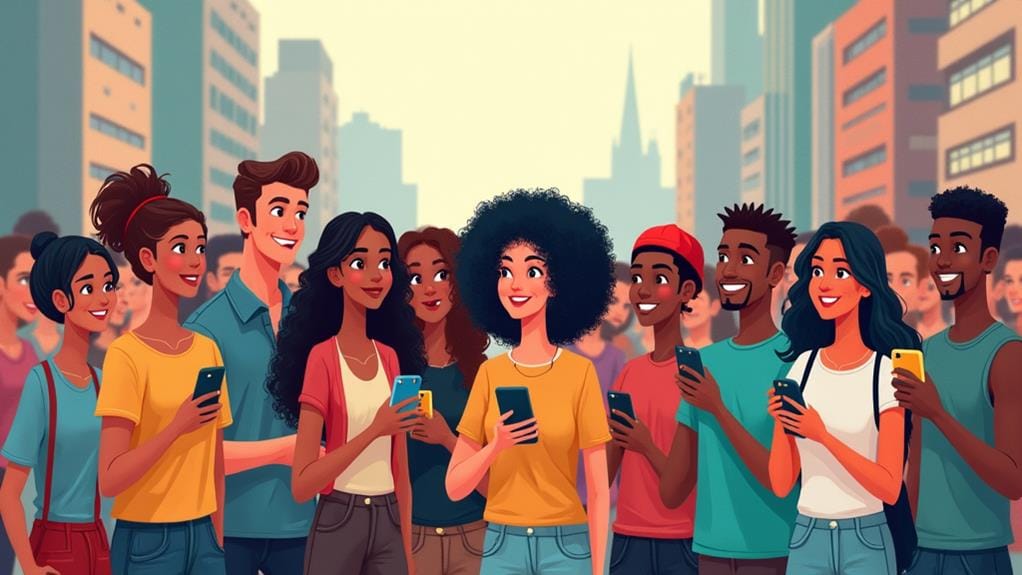

As you endeavor to connect with local consumers on social media, it is crucial to grasp the psychological drivers behind their preferences and purchasing decisions. Their emotional responses, cultural norms, and social identity play a significant role in shaping their behavior. By understanding these factors, you can tailor your content and marketing strategies to resonate with your local audience. For instance, using local language and visuals can foster a sense of community and boost engagement. By recognizing the importance of cultural relevance, you'll be better equipped to adapt your approach and strengthen your connection with local consumers, leading to more effective social media strategies.
As you explore the world of local consumer behavior, social media emerges as an essential platform for understanding the intricacies of local consumer psychology.
You find that local consumer behavior is heavily influenced by cultural norms and social identity, with 33% of Americans using social media to discover new products and brands. Additionally, effectively tailoring products and marketing to local preferences can considerably enhance engagement levels.
Emotional responses play a vital role in shaping local consumer preferences, as content that resonates with audience emotions tends to increase engagement and sharing.
Analyzing comments and feedback on social media platforms can uncover cultural insights and emotional drivers behind consumer behavior, enhancing your brand strategies tailored to local preferences.
You can gain valuable customer[3] insights from online engagement, which directly informs your understanding of local consumer psychology. In fact, 90% of businesses reported gaining increased customer insights from online engagement.
You've gained a deeper understanding of local consumer behavior and the importance of social media in shaping their preferences.
Now, it's time to develop effective marketing strategies that speak to their motivations and desires. Crafting engaging content is vital to creating a sense of community on social media platforms.
To achieve this, understanding local culture is essential, as it informs the use of relevant slang and symbols that resonate with your audience.
To create impactful marketing, consider the following strategies:

The power of cultural events and trends on social media can't be overstated, particularly when it comes to engaging local consumers. By leveraging social media to tap into cultural events, you can create a profound impact on the consumer experience, fostering a deeper sense of connection and community.
Events that resonate with your target audience, such as local festivals or cultural celebrations, can be highlighted to enhance engagement and showcase your brand's involvement in the community leveraging local events.
When you craft content that aligns with local customs and celebrations, you showcase your commitment to cultural sensitivity, which can lead to increased brand loyalty.
Utilizing local language, idioms, and visual elements that reflect community landmarks creates a sense of familiarity, making it more likely for consumers to resonate emotionally with your brand.
Understanding Consumer Psychology
Delving into the intricacies of consumer psychology reveals the profound impact that cultural norms and social identity have on local consumer behavior. As you analyze social media interactions, you'll uncover the complex layers of purchasing decisions and brand loyalty within specific communities.
To truly understand local consumers, you must grasp the emotional and psychological drivers behind their preferences. Active engagement on social media platforms can enhance local visibility and reflect the community's cultural values, influencing purchasing behaviors and brand perceptions.
Additionally, social media impacts SEO through boosted brand awareness, which is essential for connecting with local audiences.
Three key aspects of consumer psychology to examine:

Numerous brands struggle to establish a genuine connection with local consumers on social media, often due to a lack of understanding of the community's unique cultural values and traditions. To overcome this challenge, you need to develop strategies that authentically reflect local culture and traditions, fostering trust and credibility among local consumers. This approach leads to stronger emotional connections with your brand.
| Strategy | Outcome |
|---|---|
| Tailor messages to incorporate cultural values | Higher engagement and impactful marketing outcomes |
| Utilize social media for two-way conversations | Enhanced brand loyalty and community engagement |
| Engage in community events and discussions | Demonstrated commitment to cultural sensitivity and authenticity |
| Analyze social media feedback | Uncover psychological drivers behind local consumer behavior |
| Develop culturally sensitive content | Stronger emotional connections with local consumers |
By establishing a strong community brand presence on social media, you'll be better equipped to build trust and credibility with local consumers. This involves creating content that authentically reflects local culture and traditions, fostering emotional connections that drive loyalty and community ties.
Engaging with local audiences through location-specific content can greatly enhance your brand's visibility and relevance. When you tailor your messaging to resonate with cultural values and preferences, you'll engage your local audience more effectively, leading to increased loyalty and advocacy.
Here are three key benefits of building a community brand presence:

The ever-changing cultural landscape presents a challenge for brands seeking to remain relevant and connected to local consumers.
As you navigate this shifting terrain, you'll want to tap into social media data to gain insights into consumer behavior. This will help you identify and respond to emerging cultural trends and preferences effectively.
With 33% of Americans using social media to discover new products, adapting your messaging to align with shifting cultural interests is essential.
As you explore measuring the success and impact of your social media efforts, it's vital to track key performance indicators that go beyond mere vanity metrics.
You need to analyze social media feedback to gain deep insights into local consumer psychology and identify emotional and psychological drivers behind purchasing decisions.
To effectively measure the success of your social media campaigns, focus on the following metrics:
You'll notice social media influences consumer behavior in 4 ways: building trust through social proof and personalized marketing, fostering brand loyalty via emotional connection and community engagement, leveraging influencer impact, and driving purchases through targeted promotions.
As you navigate social media, you're driven by a desire for social connection, emotional engagement, and identity expression. You're also influenced by the fear of missing out[1], seeking social validation, and struggling with information overload, all while cultivating brand loyalty.
You're influenced by cognitive biases, emotional triggers, and social proof when making purchasing decisions. Group dynamics and identity expression also shape your choices, ultimately driving decision making and brand loyalty through subtle, yet powerful psychological forces.
You understand consumer psychology by recognizing cognitive biases and emotional triggers that drive decision-making processes, analyzing how brand perception is shaped by trust factors, social proof, and cultural influences, and empathizing with consumers' needs and desires.
